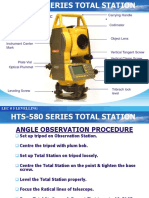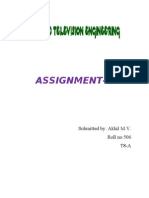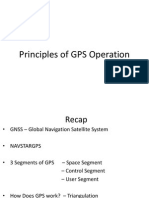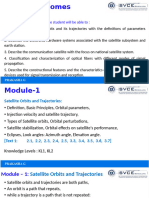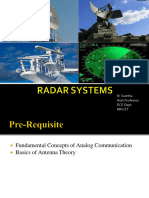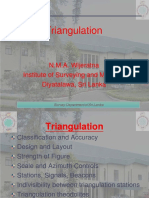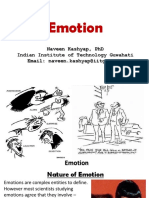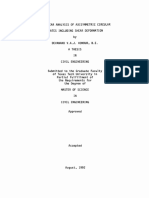GMAT1110 Summary
GMAT1110 Summary
Uploaded by
Benjamin BrownCopyright:
Available Formats
GMAT1110 Summary
GMAT1110 Summary
Uploaded by
Benjamin BrownOriginal Description:
Copyright
Available Formats
Share this document
Did you find this document useful?
Is this content inappropriate?
Copyright:
Available Formats
GMAT1110 Summary
GMAT1110 Summary
Uploaded by
Benjamin BrownCopyright:
Available Formats
GMAT1110 Summary
Introduction:
Surveying/Geospatial Engineering science and art of determining relative
positions of features in environment
Branches of Surveying:
o Geodetic (large scale, high accuracy). Use spherical angles (lat+long)
o Plane (1-2km max, reduce measurements to horizontal plane)
Use rectangular coord system, or polar
Ellipsoid close fitting, regular mathematical surface to represent Earths shape
North
o True north north pole/spin axis of Earth
o Magnetic north where compass points, moves with time
o Grid north grid lines of defining coordinate system
o Arbitrary north local north for specific project
Bearings vs Angles. Bearing from north.
Errors:
o Gross (inexperience, inattention, fatigue, poor technique)
o Systematic (usually accounted for with constant sign, known source of error)
o Random (inability for perfect measure, small magnitude, random sign)
GPS (Global Positioning System): (available 24hrs, military system)
GNSS Global Navigation Satellite Systems
History:
o Development work in 1973, first satellite 1978, last experimental satellite
1985
o WGS84 (World Geodetic System) satellite datum 1984 (refined 2002)
Earth-centred, fixed global reference frame.
o Newer Block satellites 1989 onwards, Block IIF from 2005-2015)
o Selective Availability (SA) 1990-2000 (decrease civilian accuracy), President
Clinton turned it off
o Anti-spoofing (AS) introduced 31st January 1994 (encrypt L2 frequency code)
o Fully operational mid-1995
Segments: Control is ground dishes, space segment is satellites, user segment.
o Control: 5 monitor stations (near Equator), tracking satellites and
transmitting info to Master Control Station (Colorado Springs). 4 of these are
upload stations
o Space: 30 active satellites in orbit, on 6 nearly circular orbital planes approx
20,200km altitude. 55O inclination, 11hr 58min orbits, At least 4 satellites
always visible
Satellites maintain accurate time (atomic clocks), receive and store satellite
ephemeris (uploaded by control segment), transmit information and ranging codes
Transmit sata on 2 L-band carrier frequencies (L1 is higher frequency to L2. New
satellites also L5 frequency which is lower than L2)
o Carriers modulated with different
ranging codes, and with a Navigation
Message containing satellite cords,
Chris Boyd
clock error, status
Satellites appear 4 min earlier each day at same elevation and azimuth from point
Azimuth angle from north; zenith angle from vertical
Ephemerides position of satellites at specific time
DOP Value (Dilution of Precision) small DOP is good, by increase vol. pyramid
Signals: Ranging codes(P-code or CA code) say the time is, Nav message has position
Position relies on distance to each satellite (measured by radio waves), then
intersection of spheres from these satellites (at least4 sats required, provide lat,
long, height and receiver time).
How GPS works
o Each satellite broadcasts unique ranging code
o Receiver on ground generates identical ranging code
o Satellite code lags receiver-generated code by signal travel time (0.06-0.08
sec)
o (Pseudo)range = time x speed of light
o To overcome clock synchronisation offset, 4 satellites used
(sqrt(x+y+z)+cdelta(t)=pseudorange, calculate delta(t)
WGS84 is military only, so we use GDA94 (Geocentric Datum of Australia)
o Use Universal Transverse Mercator (UTM_ projection to get Map Grid of
Australia (MGA) with Eastings and Northings
Ephemeris provides high accuracy position of satellite (in WGS84)
Almanac course position of all satellites relative to each other
GPS gives position information, velocity, time, (doesnt give heading)
95% confidence level, vertical accuracy 1-5-2 times less accurate than horizontal
Civilian GPS 5-10m accuracy
To improve accuracy, use relative rather than absolute positioning, or carrier phase
lengths
Differential GPS one base station GPS receiver (at known point), others placed at
unknown points. correction at base station applied to GPS
GPS Nav uses absolute positioning, GPS Surveying uses relative positioning
relative has accuracy <1x10^8 ppm, absolute <20m
Carrier Phase measurements (ambiguous) use number of wavelengths plus fraction
Static/Rapid Static technique 2+ receivers observing same satellites, high precision
Geodetic surveys (static baselines), Minor control surveys (rapid static), Point
coordination (stop&go, kinematic), Mapping/GIS capture (PR-based DGPS)
Use: Large detail survey, GPS-based guidance/control (tractors),
GPS gives ellipsoidal height, AHD gives MSL (the geoid/gravity field). Separation
must be applied for GPS levelling
Point Positioning (code): 5-10m, one receiver
Differential GPS (code): <1m, need radio/comms link
Real-Time Kinematic (RTK) (carrier phase): 1-2cm for 10km, 2-4cm high, expensive
Static post-processed (carrier phase): 5mm, 1000s kms, slow, expensive
Levelling:
3D position by height difference (levelling), angles (theodolite), distance (tape, EDM)
geoid is the gravity field
to level, use pendulum, liquid surface, bubbles
Chris Boyd
Levelling measuring or setting out height difference between 2 points
Hydrostatic levelling (water in pipe), Spirit levelling (normal), Trigonometric
levelling (using slope distance and angle)
Spirit levelling: horizontal line defined by instrument, graduated staff, using
absolute height benchmark
We use tilting level, bubble to level, crosshairs, look at staff
Collimation line/height horizontal surface
In automatic level, compensator adjusts for slight mislevelment
Digital level reads barcode on graduated staff. Reads staff intercept and distance
Rotating laser levels are an active system (all others passive)
Most height datums based on mean sea level (MSL). AHD71 (Aus Height Datum)
Back Sight, Foresight, Intermediate Sights, Change Point (staff position before
moving level), Height of Collimation
Reduced Level (RL) is its height above AHD71
Bench Marks (BMs) are marks with known RLs (temporary or precise)
Use BM RL and back sight to find HoC, then work forwards
Instrument out of adjustment perform 2 peg test
acceptable misclose
Tolerance for levelling is E=+Csqrt(K), where E is misclose in mm, C is constant, K is
distance
Spread misclose across points, so you have an adjusted reduced level
Curvature and Refraction affect readings
Orientation and Theodolites:
Orientation for north by compass (magnetic), by sun (true), by stars (true), by
gyroscope (high spinning, freely rotating object which points true north, great for
mining and tunnelling), GPS (join between coordinates)
Ore bodies affect field of gravity, so alter north. As do electromagnetic waves
Theodolite measures horizontal direction and zenith angles
To level, use spot bubble (rough), plate bubble (main), and compensator
Centred with plumbob, optical plummet, centring rod, centring laser
Setting up: place over mark and push one leg in. rotate on other legs until crosshairs
of OP on mark. Use footscrews to refine centring. Centre spot level sliding tripod legs
up and down. Use plate bubble to complete process. Unscrew tribach and slide so
crosshairs of OP over survey mark
Temporary adjustments centring, levelling, parallax
permanent adjustment problems plate level out of adjustment, optical plummet
out, horizontal collimation error, vertical circle index error, trunnion axis
dislevelment
Keep FL for all Mean and reduced mean
Reduced mean first mean reduced to 0 00 00, all others have same subtracted off
them
Grand mean is mean of multiple runs between same points
Round up if 0.5
Errors:
Chris Boyd
o Horizontal Collimation error line of sight not perpendicular to trunnion
axis, found by comparing face left and right (d = FL (FR+- 180))
FLcor (Face Left correction) = -0.5 x d
o Trunnion axis tilt error axis not perpen. to vertical axis, FL and FR fix
o Vertical Circle Index Error detected by FL and FR (e=360-(FL+FR))
Taking FL and FR does NOT eliminate effect of inclined vertical axis (but minimum
effect if targets at low elevation)
Distance:
Electronic Distance Measurement (EDM) electrically measures distance, high
accuracy. Integrated with total stations
GPS used for long lines
Tape measurement 30m steel tapes, 100m steel bands, EDM, fibreglass
Stadia method lines on crosshairs, intercept on staff is function of distance
Steel bands need correction according to technique and environment
EDM prisms mounted on tripod/range pole, use reflective paint or natural surface
Corner cube (3 surfaces) reflectors send light back the way it came
EDM:
o Pulse method short intensive pulse of energy sent to reflector, transmitted
back along same path. Distance speed x time/2 (plus correction).
o Phase Difference Method: continuous modulation of carrier wave sent to
reflector. Return signal compared to signal in EDM. Distance derived from
phase difference scale by velocity, after ambiguity resolved. (3 or more waves
compared, or one modulated wave to determine nearest metre, then find the
number of waves for smaller wave).
EDM errors:
o Scale error change in temp or atmosphere, timing error
o Zero error independent of distance, caused by instruments (ageing)
o Cyclic error varies with distance, instrumental and non-instrumental causes
o Slope-to-horizontal, horizontal-to-sea level, sea level-to-projection
o Periodic calibration required on standard baseline
o Accuracy written as (A mm + B ppm)
Can use GPS (2 receivers measure simultaneously). All distances combined to derive
distance. Use pseudorange (course) or carrier phase (accurate)
Coordinates and Calculations:
Coordinate systems are geographical (spherical) or Geodetic (ellipsoidal)
Local Cartesian coordinate systems same scale, flat earth approx, convenient
Map projection allows ellipsoid to be represented on flat paper
We mainly use the Universal Transverse Mercator system (UTM)
Datum is model of size and shape of earth, map projection is mechanism to
represent on flat surface
Geocentric Datum of Australia (GDA) moves all AMG (Australian Map Grid)
coordinates. Now call Map Grid of Australia (MGA)
MGA aligns to global satellite coordinates
Calculators:
Chris Boyd
Dont claim more accuracy than you measure!
Only round the final answer
For area, sides between 5 and 5, calculate area of upper and lower, then average
For inverse tan, look at sign of cos and sine to determine which quadrant
B(su) = Bu Bs
P R: SHIFT Rec(distance SHIFT , angle in D-M-S)=
RCL ALPHA Y gives Y coord (delta E), RCL ALPHA X gives X coord (delta N)
R P: SHIFT Pol(northing SHIFT , Easting) =
RCL ALPHA Y gives theta
Geographic Information Systems (GIS):
Used in navigation, topographic mapping, aeronautics, soil survey/mapping,
geology/mining, oil/gas/minerals, agriculture, crime mapping, disaster/crisis
management, disease mapping, environmental monitoring, development, transport
GIS relates surveying, demography and represents on map (cartography)
First use in 1962, Canada
Parts people, software, hardware, analysis, data
80% of data has a spatial component
allows to capture, analyse, store, display, query and provide an output
Captured from paper maps, digital sources, GPS and coordinates
Stored in vector formats (lines) or raster formats (area)
Query to identify specific features, input conditions
Analysis to find proximity, overlay information, or show network
Display in maps, graphs, reports
Output on internet, as paper map, an image or document
Answer questions by comparing different layers of data
Spatial data has Attributes (data), Geometry (where) and Behaviour (set of rules)
Using vectors, represented as points, lines or polygons
Using raster, represented in matrix of equal sized cells, store sample of information
o Advantages of raster: simpler data model, faster processing/display,
additional analytical tools, better for unbounded info
o Disadvantages: generalisation of area, loss of feature uniqueness
Connectivity list of included vertices between nodes
area definition polygons represented by list of arcs
Model simplification of the real world to assist understanding/interpretation
Models representation (describe landscape), suitability (best place for something),
process (show interaction and change), automated work flows (data processing)
Issues with GIS: cost (of hardware, data, software and people), complexities of data
output, managing the errors in the information (not always correct)
Future of GIS: geovisualisation (of future cities), augmented reality (google glasses),
Mars exploration,
GIS shows how to interpret/visualise data, not where the data actually is
Elements of cartography need to be considered (audience, objective, technical limits,
mode of use, need to generalise, scale, reality)
Visual Balance visual centre 5% above geometric centre, layout and weight
considered
Reference system required, north arrow, etc.
Chris Boyd
Colour can be important (bias information, to interpret correctly, 12 shades max)
Remote Sensing:
Definition: collecting information with no physical contact
Sensor (on plane, satellite) records reflected energy from Earths surface
Used in agriculture, forestry, oil and gas, military, disasters, environmental
Common use: Land classification, change detection (new buildings, etc.)
Active remote sensing generates radiation and measures electromagnetic energy
reflected off a surface (inc. LiDAR and RADAR). Can penetrate obstructions and used
night or day
Passive remote sensing uses reflected (visible and shortwave infrared wavelengths)
or thermal energy from a surface (energy source from outside the sensor ie Sun)
Characteristics of system: Energy source, interaction of radiation with atmosphere,
interaction of radiation with target, reception of radiation at sensor, data transfer
and ground receiving system, data storage/archive, data
process/analysis/application
Satellite Orbits:
o Geostationary/Geosynchronous: satellite fixed over same spot on Earths
surface, period of 24hrs, high orbit (35,800km), large pixel sizes,
observe weather patterns, surface temp, etc
o Low Earth Orbit: 400-800km, travel fast, much higher resolution, ground area
observed is smaller (limits frequency a point can be observed)
Polar Orbit: passes by both north and south poles, 90 degree
inclination of orbit
Sun Synchronous: over the same position at same time of day
Uses: Aerial photography, orthophotography
Difference in sensors:
o Satellite global coverage, high update rate, imagery from library, lowmedium resolution, fixed orbit
o Airborne local coverage, no continuous update rate, long delays, unknown
quality, medium-high resolution, flexible
Issues with remote sensing: amount of data, spatial resolution (but getting better),
spatial accuracy, interpretation of data
Temporal resolution repeat time of platform, how long to complete one series of
orbits so instrument at original position
Multispectral analysis identify materials based on spectrum of light, rather than
spatial characteristics
Hyperspectral (lots of bands), can also have 1 band
Control Networks and Traversing:
To survey large area, establish several control points, measure with high accuracy,
then fill in between with lower accuracy and cheaper methods
Several control networks run across Australia, NSW, and the world to ensure
accuracy
Benefits of Survey Control Network:
o Australia wide network of landmarks, homogenous system, marks uniquely
named/numbered, quality assurance, compatibility of survey data, marks
easy to locate, minimise duplication of data
Chris Boyd
Different survey methods to position a point:
o Radiation: Set up station away from reference object, take bearing to that
object, change angle a set amount and distance to the new coordinated point
o Intersection: Set two stations with a known bearing between them, take an
angle from each station to the new coordinated point
o Resection: Take a known angle and bearing from 3 known points to a new
point
o Traverse: Either closed loop traverse (ends on the stating point) or closed
link traverse (between two fixed survey stations)
Open traverse also possible, but no contingency
Traverse Design issues:
o Permanent/stable markings
o Select station by thorough reconnaissance
o Purpose of survey dictates shape and locations of traverse stations
o Minimise errors: lines of equal length, no short lines, avoid obstacles
How to do a traverse:
o Set up at known starting point
o Measure bearing to new traverse station (by measuring angle between
reference object and initial traverse station)
o Measure distance to new traverse station
o Move to first traverse station
o Measure distance to next unknown
traverse station and horizontal directions
backwards and forwards
o Move again and repeat
o Usually 1-2 arcs measured at each station
with theodolite (one measurement = FL(B)-FL(C)-FR(B)-FR(C) when
measuring from a point A)
Adjustments:
o Reduce all distances. If 2 runs, reduce separately THEN take mean
o Find angular misclose and calculate adjusted bearings
Loop misclose = sum interior angles (n-2)*180
Closed link misclose = sum angles + start bearing closing bearing
(n-2)*180
o Calculate coordinate differences between stations, determine accuracy of
traverse, then adjust coordinate misclose
Bearing CD = Bearing DC +- 180
Bowditch Adjustment to distribute length misclose over all measurements
Corr(E) = -misclose(E) * length leg / total length trav. Similar for northing
Class Notes (extra):
10 = 5mm at 100m
1 = 3cm at 100m
For 2nd run using theodolite, start angles from 90degrees (accounts for index errors)
Chris Boyd
After Mid Sem break:
Areas and Volumes:
Conversions:
o 1 hectare = 100x100m = 10000m2
o 100ha = 1 square km
o 1 foot = 12 inches
o 1 chain = 100 links = 66 feet = 22yards
o 1 acre = 0.4ha
Area:
o By Triangles: Convert polygon into smaller triangles and sum each area, A =
0.5xbxh,
Where 2 sides and an angle are known, sine rule (A = 0.5 a b sin(C))
Where 3 sides known, A = sqrt[s(s-a)(s-b)(s-c)], for s = 0.5 (a+b+c)
o By Coordinates (much more relevant)
Uses trapeziums on coordinate axis to calculate area
Draw a diagram, then divide into trapeziums. Subtract excess areas
using trapezium
Area trapezium = 0.5 h (a+b)
o Zig Zag Method uses trapezium formula
Area = 0.5 [(NAEB NBEC ...NEEA)(EANB EBNC ...EENA)]
Ensure coords of start point appear at end as well
0.5 x (sum of backwards sum of forwards)
o Rounding off number of s.fs in coord with least number of s.fs
Slope 1:k or 1 in k. Slope angle is arctan(1/k)
For curved areas, approximated with
o Trapezoidal Rule: A = L/2 (first height + last height + 2(all other heights))
Where L is the length of each section
o Simpsons Rule: A = L/3 (first + last + 4x(even offsets) + 2x(odd offsets))
Number offsets must be odd for rule to apply
Chris Boyd
Simpsons Rule is more accurate
Volumes:
o Mean Area Method: Volume = total length * sum (each cross sectional area)/n
Where n is the number of cross sectional areas considered)
o End Areas make each side section into trapezium, calculate area then
volume of each section. Sum for volume of the whole
Accurate if all areas similar size
o Prismoidal Formula (Simpsons Rule for volumes)
N must be odd!
Volume = L*{A1 +An +4(even Ai ) +2(odd Ai )}
Most accurate method
For curved centrelines, use Pappas Theorem: Multiply the area of each section by
1+c/R, where c is the offset between centreline and centroid of cross-sectional area
for section, and R is the radius of the curve. This is not useful.
Volume by contours treat contour lines as cross sections, and vertical interval as
height. Use previous methods to calculate volume of each
Use of spot heights: Volume determined by dividing area into square and finding
spot height above a datum at each corner.
o Then, volume = Area/4 (sum single depths + 2*sum double depths + 3*sum
triples + 4*sum quadruples)
o This assumes that surface slope is constant between spot heights
Rounding off Coordinates quoted to 1m have assumed accuracy 0.5m
o Calculate a worst case scenario) by adding 0.5m to all coordinates and
finding final volume/answer.
o Then, quote to accuracy of both original answer and worst case scenario
Detail Surveys:
A detail is a large-scale plan showing manmade and natural details
Process:
o Prepare for the detail survey
Accuracy requirements of client, amount and type of detail to collect,
CAD standards
Plans have limited accuracy about 0.2-0.3mm
Scales must be appropriate to include detail
Accuracy required of contours dictates the density of Spot Heights
Every organisation has its own CAD standards
o Establish control points
Choose suitable points with good visibility
o Collect data in the field
Range of techniques available
Plane table mapping
Using drawing gear, radiations and distances
Chain surveys
Using measuring tape only
Theodolite and tape survey
Using radiations and distances to known points
Chris Boyd
Optical distance measurement no electronics, slower and less
accurate than electronic tacheometers
EDM Tacheometry (Total Stations)
Electronic measurement of angle and distance, data recording
Traversing, set-outs and detail surveys can be carried out
rapidly
Ideal for detail surveys field to finish surveying. Can code
using keyboard, barcodes etc. Computer software available
o Plotting and presentation of data
Computer contouring/data presentation
Electronic data recording
Field coding records measurements (point ID, direction, ZA, slope
distance) and codes/comments (date, height of target, coordinates,
feature ID)
Procedures:
o Set up instrument at known position and height (from control survey)
o Orientate instrument to another control point
o Radiate points of detail
o Use check measurements (check back on orientation point regularly)
o Calculate coordinates and height
To calculate E, N and height of a point, need instrument height, height of target (from
slope distance, vertical angle, horizontal angle, bearing), point code
o RLB = RLA + HI + v - HT
FL and FR Theodolite Measurements
o 2 faces requires repeat observations mean reduces random errors,
differences detect gross errors
o 2 faces also reduces systematic errors trunnion axis tilt, horizontal/vertical
collimation error
o 2 faces DOES NOT reduce vertical axis (levelling) tilt or centring error
o A traverse/control uses 2 faces, a radiation uses 1 face
1 face makes observations faster and plotting requires low precision
Large amount of digital data already available in GIS databases (for large scale only)
Real-time Kinematic (RTK) GPS for detail surveys
o Requires 2 GPS receivers and a radio link for real-time differential
positioning. Allows cm-level accuracy, high productivity, needs high visibility
Photogrammetry low flying plane with high resolution camera takes overlapping
images
o Can be used in conjunction with airborne laser scanning use of laser in
plane to calculate elevation of surfaces. Requires accurate information of
orientation and position of plane during flight
o GPS for position, IMU (Inertial Measurement Unit) for pitch, yaw and roll of
plane
3D laser scanning tripod mounted device, measures flight time of emitted
radiation to produce point cloud of 1000s of points for accurate 3D detail and
mapping
Mobile laser scanning vehicle mounted device, uses 3D laser scanning
Chris Boyd
Deformation Surveys:
Steps in construction surveys:
o Cadastral - defining land boundaries
o Control placing benchmarks to control proposed construction
o Set-out placing marks for builders to locate formwork, foundations, etc
o As Built/Work As Executed checking for compliance with
client/government specifications
Try to design survey to measure deformation directly (monitor verticality,
subsidence and distortion in 1D, 2D and 3D)
Sensors may be placed directly inside structures during construction
Many projects require non-invasive methods
Some methods accurate to 1mm
Photogrammetric method used to monitor many points (building facades)
GPS used for large areas and for points not intervisible (measurements to other
points)
Used for volcanoes, mines, disaster management
Laser scanning can be used
Nationwide permanent GPS network used for monitoring crustal
motion/deformation
Construction and Setout Surveys:
Coordinate system considerations:
o May be aligned with axes of building/structure, rather than north
o Horizontal axes as X and Y, Height/RL may be referred to as Z
o Local bearings measured from Y-axis generally
o Grids and axes must be physically related to building site
o Grids generally set out on each floor of building
Legal requirements must be met outer wall design location (legal and functional
requirements)
Distances on a plan are horizontal!
Accuracy must be appropriate for job (ie formwork doesnt need mm accuracy)
o Prefabricated sections require absolute accuracy
Cadastral survey minimum frontage, lot sizes and boundary displacements
For marks to be set at specific horizontal distance and direction (as in setout prac)
o Select EDM/theodolite display for horizontal distance and direction (or
measure ZA and calculate slope distance)
o Real time GPS techniques can be used
o For permanent alignment, use rotating laser
o Express design positions in coordinates
o Compute bearing and distance from CP to design position
o Set up total station over control mark
o Orient instrument to known Reference Object (RO)
o Turn computed bearing to required position
o Measure computed distance along direction defined by total station
Chris Boyd
o Place mark at correct distance and bearing
Can setout by Radiation (use angle from known RO), setout by intersection
(intersection of 2 radiations from CPs), setout by offset (right angle between 2
targets)
Using 2 faces of angle in setout mean of FL and FR is the point
Do checks multiple times to prevent gross errors (misinterpretation of plans)
o Checks from 2 CPs to all other points is minimum
Offsets placed in line (on axes) of corner pegs, increase reliability and minimise
errors. Security of pegs! Allows corner marks and axes to be re-established if corner
marks destroyed (in the way of construction)
Sight rails used to ensure height datum across project (top of rail is constant height)
Rotating laser levels define a plane (either flat or standard incline) visible and
infrared
o Further developed for single grade (constructing simple incline plane) or
dual grade (constructing a plane inclined in 2 directions eg irrigation runoff)
Free station set up instrument at convenient location, perform resection (measure
to 3 or more known control marks), then set out design from there
Robotic instruments track prism and allow for one person operation
o Some instruments have lights to indicate when prism in line
Verticality surveys ensure surface is vertical
o Require 1 in 1000 accuracy (1mm per m is acceptable)
o May be done with theodolite (difficult in confined space), auto-collimator
(defines zenith), laser devices (less accurate), or plumb bobs and steel tapes
(effective and cheap)
May need to transfer control in multi-storey construction, use optical plummet
through the levels
Cadastral:
Land is described by its location (lot number, parish, county) and measurement
o Transactions are registered by the Land Titles Office (LTO) to show the
details of the land and the ownership, mortgages and other conditions
o Information is kept in the Registrar-Generals Office of the Department of
Lands, document of ownership is the title
o Register of ownership of titles is the cadastre
o Cadastral survey forms or maintains the cadastre
Cadastral surveyors measure to define locations of corners/boundaries of land, the
plan of which is registered with the Title.
o Also use understanding of law to resolve ambiguities/contradictions in
evidence for the locations of boundaries
50-75% of Gross National Wealth of developed countries depends on secure system
of land titling/ownership
Development of land ownership:
o English settlers assumed Terra Nullius (no settled inhabitants/legal
system). All land proclaimed Crown Land. Laws from England/adapted
English law/developed over time in each colony
Chris Boyd
o Originally, no survey control. Land defined by measurements and limits,
recognisable features, or relating to existing land parcels
o Crown Land granted to free settlers descriptions of the land vague, and
often granted before it was marked on the ground. Land measurement
techniques were rough. Dimensions scaled off small scale index maps
o Early land measurement: magnetic compass (+- 2 degrees accuracy),
distances by Gunters chain/pacing, often an extra link placed in the chain
NSW has a Central, Eastern and Western division County Parish Lot
Ownership of land can be defined under Crown Lands (Government owned and
used), Crown Grants (Government-granted for others to use), Old System Title (from
English Common Law), or Torrens Title (new way of land definition)
o OS Title being transferred to Torrens Title
Torrens Title (1862) all documents to prove ownership replaced by a single
document. 3 principles apply:
o Mirror feature the Registrar is a true reflection of the tenure
o Curtain feature no search required for undisclosed interests
o Insurance feature the State compensates the owner for deprived interests
On top of that, 5 key principles:
Title by registration (interest in land acknowledged)
State registration (State guaranteed)
Based on land not people (parcel of land key indicator)
The Register (ALL parcels maintained in one place)
Indefeasibility (not to be annulled or made void)
Strata Title in NSW (1961) introduced to reflect ownership of apartments (vertical
element as well as land). A Strata Plan divides building into separate lots and
common property.
Cadastral surveyor uses measuring skills to locate the parcel subject to sale on the
ground, and knowledge of relevant laws to describe land boundaries.
o Must be registered and licensed by the State. Needs 4 year degree, further
practice and exam, need to maintain currency of knowledge
Fences do not equal boundaries, do not build on easements, get a survey done before
work begins (if in doubt)
Conduct a SCIMS search for survey marks
Chris Boyd
You might also like
- School M&E System HandbookDocument61 pagesSchool M&E System HandbookVictoria Beltran Subaran86% (29)
- Unit 3 Mid-Term ExamDocument6 pagesUnit 3 Mid-Term Examapi-366990800No ratings yet
- GPS Surveying Dr. Jayanta Kumar Ghosh Department of Civil Engineering Indian Institute of Technology, Roorkee Lecture - 07 GPS Positioning (Principle and Methods)Document16 pagesGPS Surveying Dr. Jayanta Kumar Ghosh Department of Civil Engineering Indian Institute of Technology, Roorkee Lecture - 07 GPS Positioning (Principle and Methods)Amrit SainiNo ratings yet
- 436 33 Powerpoint Slides CHAPTER 1Document69 pages436 33 Powerpoint Slides CHAPTER 1Shailendra Kumar Jain100% (1)
- TR210028en ADocument90 pagesTR210028en AM. Abdullah Reza D.HNo ratings yet
- A Sidereal PointerDocument16 pagesA Sidereal PointerGildásio AmorimNo ratings yet
- OJTDocument19 pagesOJTKiran PadalaNo ratings yet
- Total StationDocument7 pagesTotal StationkhajaimadNo ratings yet
- Lab 03 4Document8 pagesLab 03 4api-554644083No ratings yet
- COMP213WrittenTest2F19 PART A & BDocument21 pagesCOMP213WrittenTest2F19 PART A & BMd Hasan Imam0% (1)
- Water Audit PresentationDocument125 pagesWater Audit PresentationbrahmishtanNo ratings yet
- Assignment RadarDocument11 pagesAssignment RadarAnand Krishnan P V0% (1)
- 4310-04 Principles of GPS OperationDocument16 pages4310-04 Principles of GPS OperationwaicleeNo ratings yet
- EC6015 - Radar and Navigational Aids Question Bank VII Semester ECEDocument3 pagesEC6015 - Radar and Navigational Aids Question Bank VII Semester ECEDivyaNo ratings yet
- Gps Lecture NotesDocument3 pagesGps Lecture NotesJay0% (3)
- PhotogrammetryDocument45 pagesPhotogrammetryValerie VictoriaNo ratings yet
- BEC515D - SatComm - Module1Document23 pagesBEC515D - SatComm - Module1Mr. PRAKASHA G CSENo ratings yet
- Formula For Launching of SatelliteDocument3 pagesFormula For Launching of SatelliteTidus FarronNo ratings yet
- Survey Using CompassDocument52 pagesSurvey Using CompassPranav VaishNo ratings yet
- Chapter 1 - Differential GPS: RTO-AG-160-V21 1 - 1Document18 pagesChapter 1 - Differential GPS: RTO-AG-160-V21 1 - 1ravifireblade8402No ratings yet
- Ppt-Open Area Test SiteDocument15 pagesPpt-Open Area Test SiteRoji Varghese Rajan100% (1)
- What Is GPS? What Is GPS?Document27 pagesWhat Is GPS? What Is GPS?tarunamritaNo ratings yet
- 2003 - Discretization Method DC MotorDocument4 pages2003 - Discretization Method DC MotorTheodoroFirmoNo ratings yet
- 04 Chapter 4 - LevelingDocument110 pages04 Chapter 4 - LevelingIsmael Wael SobohNo ratings yet
- Challenges and Solutions For GPS Receiver Test: AgendaDocument23 pagesChallenges and Solutions For GPS Receiver Test: AgendaHung PhamNo ratings yet
- θ is swept out between t = 0.5 h and t = 1.5 h after perigee passage?Document1 pageθ is swept out between t = 0.5 h and t = 1.5 h after perigee passage?BellatrixMacabre0% (1)
- 8 TraverseDocument8 pages8 TraverseSubbu PemmasaniNo ratings yet
- Lecture 4 - Compass Surveying SlidesDocument48 pagesLecture 4 - Compass Surveying SlidesReceb AgaNo ratings yet
- Surveying BasicsDocument35 pagesSurveying BasicssrinivasanNo ratings yet
- TopSURV RefManDocument364 pagesTopSURV RefManGradinariu IonutNo ratings yet
- EEE 363 Control Systems: Course Teacher: Md. Shamsul Arifin Assistant Professor Dept. of EEE, CUETDocument19 pagesEEE 363 Control Systems: Course Teacher: Md. Shamsul Arifin Assistant Professor Dept. of EEE, CUETRakayet Rafi100% (1)
- Trigonometrical LevellingDocument11 pagesTrigonometrical LevellingAbir MahmudNo ratings yet
- CENG60 Lab 23 1Document3 pagesCENG60 Lab 23 1Jeffrey FroilanNo ratings yet
- DownloadDocument48 pagesDownloadashok882411No ratings yet
- RS Unit-1pptDocument83 pagesRS Unit-1pptNamadi SwethaNo ratings yet
- Attitude Determination and ControlDocument57 pagesAttitude Determination and ControlMaximiliano CrescitelliNo ratings yet
- ORB - An Efficient Alternative To SIFT or SURF - Rublee - Iccv2011Document8 pagesORB - An Efficient Alternative To SIFT or SURF - Rublee - Iccv2011funny04No ratings yet
- Lecture 01 - IntroductionDocument54 pagesLecture 01 - IntroductionAhmed HamdyNo ratings yet
- Geodesytriangulation 151125092103 Lva1 App6892 PDFDocument121 pagesGeodesytriangulation 151125092103 Lva1 App6892 PDFMrunmayee ManjariNo ratings yet
- PAPER - Deformation Monitoring With Total StationDocument9 pagesPAPER - Deformation Monitoring With Total StationfranciscovelaNo ratings yet
- Antennas at Cell SiteDocument14 pagesAntennas at Cell SiteMark Abadies100% (1)
- Satellite Communication Fall 2011 Answer KeyDocument7 pagesSatellite Communication Fall 2011 Answer KeyplutopopNo ratings yet
- DGPS Stations in IndiaDocument13 pagesDGPS Stations in IndiamhegdenNo ratings yet
- ADFDocument12 pagesADFehsan1985No ratings yet
- Site LevelingDocument33 pagesSite Levelingelvin_ganNo ratings yet
- 04 Angles Directions and Angle Measuring EquipmentDocument26 pages04 Angles Directions and Angle Measuring EquipmentAnonymous dFgse0Aaf100% (1)
- Laser VibrometerDocument22 pagesLaser VibrometerWisss FisssNo ratings yet
- Original1.Week 3 Module 1 DGNSSDocument16 pagesOriginal1.Week 3 Module 1 DGNSSNishant Tiwari100% (1)
- Introduction To HRXRDDocument36 pagesIntroduction To HRXRDTrà NguyễnNo ratings yet
- Conical Equal Area Projection With Two Standard ParallelsDocument18 pagesConical Equal Area Projection With Two Standard ParallelsBiki Kundu100% (1)
- 02 - Satellite Orbital Parameters PDFDocument26 pages02 - Satellite Orbital Parameters PDFAhmed RiyadNo ratings yet
- 9-Plane Table SurveyingDocument43 pages9-Plane Table SurveyingVinayaka RamNo ratings yet
- Global Positioning System (GPS)Document21 pagesGlobal Positioning System (GPS)Rahul Sharma100% (1)
- BEC515D - SatComm - Module4Document27 pagesBEC515D - SatComm - Module4Mr. PRAKASHA G CSENo ratings yet
- Acs Lab ManualDocument46 pagesAcs Lab ManualVallabh SinghNo ratings yet
- ResumenDocument26 pagesResumendario albaNo ratings yet
- The Gps DictionaryDocument53 pagesThe Gps Dictionaryalfikymostafa92No ratings yet
- GPS Tutorial 1 PDFDocument43 pagesGPS Tutorial 1 PDFRavi ShankarNo ratings yet
- The Global Positioning SystemDocument27 pagesThe Global Positioning SystemVishu VaidyaNo ratings yet
- Inertial NavigationDocument39 pagesInertial NavigationM S Prasad100% (4)
- Space Navigation: Part I: IntroductionDocument21 pagesSpace Navigation: Part I: IntroductionFelino SibonghanoyNo ratings yet
- GPS (Global Positioning System) & DGPS (Differential Global Positioning System)Document103 pagesGPS (Global Positioning System) & DGPS (Differential Global Positioning System)NoCopyrightTunes100% (1)
- Surveying Basics For SiteDocument53 pagesSurveying Basics For SitePramodNo ratings yet
- Remote Sensing & Geospatial Technologies Dictionary: Grow Your Vocabulary, #55From EverandRemote Sensing & Geospatial Technologies Dictionary: Grow Your Vocabulary, #55No ratings yet
- BCPC Table of ContentsDocument3 pagesBCPC Table of ContentsBarangay Ditucalan100% (1)
- CBSE Class X Social Science Revision Notes Economics Chapter 5 Consumer RightsDocument3 pagesCBSE Class X Social Science Revision Notes Economics Chapter 5 Consumer RightsSatyam StRykerNo ratings yet
- Minimal Morph Space Themed Background SlidesDocument22 pagesMinimal Morph Space Themed Background SlidesfatimaezzahraNo ratings yet
- Ipv6 12 4 BookDocument648 pagesIpv6 12 4 BookHarpreet BakshiNo ratings yet
- SFG: Interpersonal MetafunctionDocument6 pagesSFG: Interpersonal MetafunctionAngela FernandezNo ratings yet
- To Book An Office Hour Meeting: Https://gordonchalmers - Youcanbook.meDocument3 pagesTo Book An Office Hour Meeting: Https://gordonchalmers - Youcanbook.mesalva1310No ratings yet
- AmortizedAnalysisExplained FiebrinkDocument16 pagesAmortizedAnalysisExplained FiebrinkVo Thanh Minh TueNo ratings yet
- Échantillon de WallpaperDynamicExtensionDocument19 pagesÉchantillon de WallpaperDynamicExtensionKiritoTugalNo ratings yet
- Time TravelDocument7 pagesTime TravelСелин КаяNo ratings yet
- Karakter Anatomi Daun Sebagai Bentuk Adaptasi Tumbuhan Penyusun Zonasi Mangrove Di Banggai Kepulauan, Provinsi Sulawesi TengahDocument10 pagesKarakter Anatomi Daun Sebagai Bentuk Adaptasi Tumbuhan Penyusun Zonasi Mangrove Di Banggai Kepulauan, Provinsi Sulawesi TengahArpin PakpahanNo ratings yet
- Install Ubuntu: Installing Ubuntu 11.10 - Step by Step GuideDocument7 pagesInstall Ubuntu: Installing Ubuntu 11.10 - Step by Step GuidePankaj BhambhaniNo ratings yet
- Kenneth Blackwell - Uncommon SenseDocument4 pagesKenneth Blackwell - Uncommon SenseEphraim Davis100% (1)
- SPSS Recode, Compute, CountDocument5 pagesSPSS Recode, Compute, CountDiana TomaNo ratings yet
- Berker - The Explanatory Ambitions of Moral Principles (2019)Document33 pagesBerker - The Explanatory Ambitions of Moral Principles (2019)Luigi LucheniNo ratings yet
- CO Manual CO-PA-04 Report PainterDocument55 pagesCO Manual CO-PA-04 Report PaintergirijadeviNo ratings yet
- Sawant Monal Sunil: Professional ExposureDocument4 pagesSawant Monal Sunil: Professional ExposureMonaal SavantNo ratings yet
- Ancova: A Hybrid of Regression and Analysis of VarianceDocument21 pagesAncova: A Hybrid of Regression and Analysis of Variancedanishrehman1985No ratings yet
- 01.bahasa Inggris II Introduction To Listening SectionDocument4 pages01.bahasa Inggris II Introduction To Listening SectionFahfu RozyNo ratings yet
- GS Quantify 2017Document5 pagesGS Quantify 2017Atharva AmdekarNo ratings yet
- Emotion: Naveen Kashyap, PHD Indian Institute of Technology Guwahati Email: Naveen - Kashyap@Iitg - Ac.InDocument31 pagesEmotion: Naveen Kashyap, PHD Indian Institute of Technology Guwahati Email: Naveen - Kashyap@Iitg - Ac.InShaik HussainbashaNo ratings yet
- Teaching ListeningDocument7 pagesTeaching ListeningMohd Zulkhairi AbdullahNo ratings yet
- Nonlinear Analysis of Axisymmetric Circular Plates Including Shear DeformationDocument76 pagesNonlinear Analysis of Axisymmetric Circular Plates Including Shear DeformationGiri DharanNo ratings yet
- COMP600 Spring Lab#2Document7 pagesCOMP600 Spring Lab#2jassica sahiNo ratings yet
- Coconut Shell Activated Carbon As An Alternative Renewable EnergyDocument6 pagesCoconut Shell Activated Carbon As An Alternative Renewable Energykim haroldNo ratings yet
- EE379B Lecture Plan - Spring 2006: Coding of Sequences and Capacity - Chapter 8Document1 pageEE379B Lecture Plan - Spring 2006: Coding of Sequences and Capacity - Chapter 8Muhammad ImranNo ratings yet
- Week 10 - Concept Notes - 0Document18 pagesWeek 10 - Concept Notes - 0Reniel MontemayorNo ratings yet







